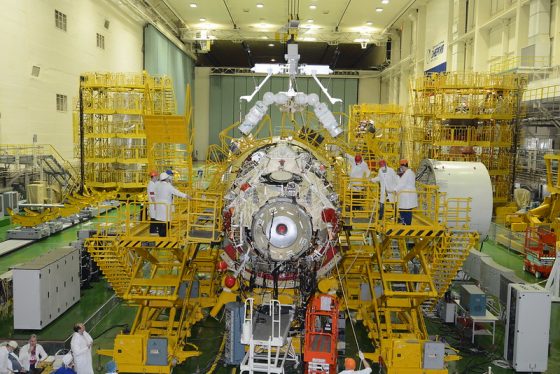The European Robotic Arm (ERA) is set for launch from the Russian launch base Baikonur on a Proton rocket to the International Space Station on 15 July at 19:18 CEST. The latest robot to service the Space Station has a length of over 11 m, and the ability to anchor itself to the Station in multiple locations, moving backwards and forwards with a large range of motion. ERA is 100% made-in-Europe. A consortium of European companies led by Airbus Defence and Space Netherlands designed and assembled it for ESA.
The European Robotic Arm (ERA) is the first robot able to ‘walk’ around the Russian segment of the International Space Station. Light yet powerful, the orbital arm has the ability to anchor itself to the Station and move back and forward by itself, hand-over-hand between fixed base-points. This space robot looks like a pair of compasses and has a length of over 11 m. When stretched, it could pass a football from a penalty spot to the goalkeeper.
Assembly tasks
The robot will serve as main manipulator on the Russian part of the Space Station. Its seven joints can handle multi-tonne payloads with a large range of motion for assembly tasks. The arm and its two control stations – one for inside and another for outside the orbital outpost – will be launched into space together with the Multipurpose Laboratory Module, called ‘Nauka’, from the Baikonur Cosmodrome, in Kazakhstan, on a Russian Proton rocket. The launch is set for July 2021, after two decades of technical and programmatic challenges.
The robotic arm brings new ways of operating automated machines to the orbital complex. ERA has the ability to perform many tasks automatically or semi-automatically, can be directed either from inside or outside the Station, and it can be controlled in real time or preprogrammed.
Save time and effort
Once it starts working from its home base at the Russian Multipurpose Laboratory Module the robot arm can help install, deploy and replace elements in outer space. ERA’s first tasks in orbit, after deployment and checkouts, are to set up the airlock and install a radiator for the latest module of the Space Station.
Astronauts will use the robotic arm to save time and effort in Space Station maintenance. It will act as a tool to transfer small payloads directly from inside to outside the International Space Station without the need for spacewalks, but will also help spacewalkers by transporting them around like a cherry-picker crane. Its four infrared cameras will support inspections and operations outside the Space Station.
Picture: ESA

